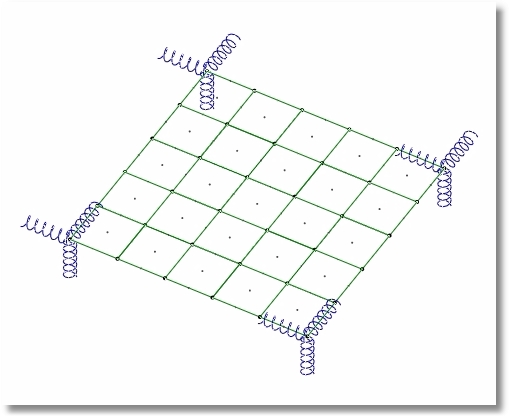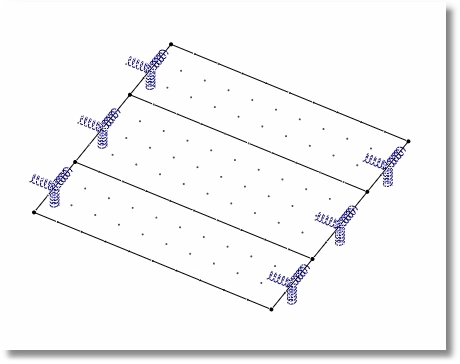Springs, like Supports, are boundary conditions. But unlike Supports, Springs can be applied to nodes (as nodal springs), members (as line springs), and shells (as surface springs). Springs also have the ability to act as linear springs, compression-only springs, or tension-only springs.
Springs are defined by a stiffness (linear or rotational) associated with one or more global degrees of freedom.
Note that the program refers to translation degrees of freedom as X, Y, and Z, which correspond to the global coordinate axes. And note that the program refers to rotational degrees of freedom as OX, OY, and OZ, representing rotation about global X, Y, and Z, respectively.
There are at least a couple different ways to define and assign springs.
Graphical Method
If you preselect the desired node or nodes, you can click Create > Boundary Conditions > Springs. Then you can select the desired spring type (nodal, line, or surface) and assign it to the selected nodes.

Nodal Springs

Line Springs

Surface Springs
Tabular Method
If you click Tables > Springs, you will be given the option to select Nodal Springs, Line Springs or Surface Springs. In all cases, you can edit existing spring data or insert new rows and create new spring assignments.
If you select Nodal Springs, the Nodal Springs screen displays. The column with the heading "6-DOFs" uses 0 for linear spring, 1 for compression-only spring and 2 for tension-only spring. All six degrees of freedom must use the same type of spring, and they listed in the following order: X, Y, Z, OX, OY, OZ. Using this syntax, you can create any type of spring you want. The columns to the right hold the stiffness values that you want to have applied in each degree of freedom.
If you select Line Springs, the Line Springs screen displays. The column with the heading "6-DOFs" uses 0 for linear spring, 1 for compression-only spring and 2 for tension-only spring. This type of spring only collects stiffnesses for the three translational degrees of freedom. All three degrees of freedom must use the same type of spring, and they listed in the following order: X, Y, Z. Using this syntax, you can create any type of spring you want. The columns to the right hold the stiffness values that you want to have applied in each degree of freedom.
If you select Surface Springs, the Surface Springs screen displays. The column with the heading "6-DOFs" uses 0 for linear spring, 1 for compression-only spring and 2 for tension-only spring. This type of spring only collects stiffnesses for the three translational degrees of freedom. All three degrees of freedom must use the same type of spring, and they listed in the following order: X, Y, Z. Using this syntax, you can create any type of spring you want. The columns to the right hold the stiffness values that you want to have applied in each degree of freedom.